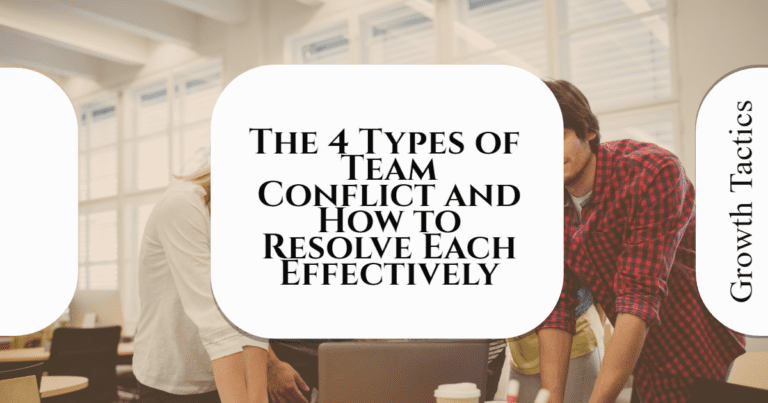In any team setting, conflict is bound to arise. It is a natural occurrence when individuals with different personalities, opinions, and ways of working come together. However, conflict does not have to be detrimental to the team. In fact, when managed effectively, it can lead to growth, innovation, and increased team performance.
In this blog post, we will explore the four types of team conflict and provide strategies for resolving each type effectively. By understanding the different types of conflict and adopting appropriate conflict resolution approaches, team leaders and members can create a positive and productive team environment.
Jump To Section
1. Relationship Conflict
Definition and Causes
Relationship conflict refers to disagreements, tension, and negative emotions that arise from personal differences, misunderstandings, or clashes in communication styles among team members. It can result from conflicting personalities, values, work habits, or past experiences.
Impact on Team Cohesion and Performance
Relationship conflict can be detrimental to team cohesion and overall team performance. It creates a negative work environment, decreases trust and collaboration, and hinders effective communication. When team members are engaged in relationship conflict, they may focus more on personal differences rather than achieving team goals.
Resolving Relationship Conflict
To effectively resolve relationship conflict, it is crucial to address the underlying issues and promote open communication. Here are some strategies for resolving relationship conflict:
Encourage dialogue: Create an environment where team members feel safe expressing their concerns and emotions. Encourage open dialogue and active listening to ensure all perspectives are heard.
Foster empathy: Encourage team members to try to understand each other’s viewpoints and communicate empathy. This helps build rapport and improve relationships within the team.
Establish clear communication channels: Set clear guidelines for communication within the team. Define the preferred modes of communication and establish protocols for resolving conflicts promptly.
Provide training: Offer conflict resolution workshops or training sessions to enhance team members’ interpersonal skills and conflict management abilities.
Facilitate team-building activities: Organize team-building activities that promote collaboration, trust, and understanding among team members. These activities can help build rapport and improve relationships.
By actively addressing relationship conflicts and fostering a supportive team culture, team leaders can mitigate the negative impact of relationship conflict and ultimately improve team cohesion and performance.
2. Task Conflict
Definition and Causes
Task conflict, also known as substantive conflict, refers to disagreements or differences among team members regarding opinions, approaches, or solutions related to a specific goal or task. It often arises from diverse perspectives, experiences, and expertise within the team.
Positive and Negative Impacts
Task conflict can have both positive and negative impacts on team performance. When managed effectively, task conflict stimulates creativity, encourages critical thinking, and leads to innovative solutions. Diverse perspectives and constructive debates can enhance decision-making and problem-solving processes. However, unresolved task conflict can hinder progress, create tension, and negatively impact team performance.
Resolving Task Conflict
To effectively resolve task conflict, it is important to create an environment that encourages open dialogue and respectful debate. Here are some strategies for resolving task conflict:
Foster open communication: Create a safe space for team members to express their differing opinions. Encourage open dialogue and active listening to ensure all perspectives are considered.
Promote diverse perspectives: Embrace the diversity of skills, experiences, and expertise within the team. Encourage team members to share their ideas and approach problem-solving from various angles.
Seek common ground: Facilitate discussions that focus on finding commonalities among different viewpoints. Look for areas of agreement and build upon those to reach a compromise or a mutually beneficial solution.
Encourage collaboration: Foster a collaborative team culture where team members work together towards a common goal. Encourage the exchange of ideas and active participation in team projects.
Clarify roles and responsibilities: Clearly define roles, tasks, and responsibilities within the team. Establish clear expectations, reducing confusion and potential conflicts.
Seek mediation if necessary: If conflicts escalate or become unmanageable, consider seeking mediation from a neutral third party to facilitate a resolution.
By managing task conflict effectively, teams can harness its benefits and use it as a catalyst for innovative thinking and improved team performance. Embracing diverse perspectives and finding common ground allows teams to achieve optimal outcomes and overcome challenges.
3. Process Conflict
Definition and Causes
Process conflict arises when team members have disagreements or conflicting preferences regarding how the team operates or makes decisions. It often stems from differences in work styles, decision-making processes, or role expectations.
Impact on Team Performance
Process conflict can lead to inefficiency, frustration, and reduced team effectiveness. It may create confusion, hesitation, and unnecessary delays in completing tasks. Unclear processes can lead to misunderstandings and breakdowns in communication and coordination among team members.
Resolving Process Conflict
To effectively resolve process conflict, teams should establish clear processes, roles, and responsibilities from the outset. Here are some strategies for resolving process conflict:
Establish clear processes and guidelines: Define clear processes, guidelines, and expectations regarding how the team operates, makes decisions, communicates, and manages tasks. Establishing protocols for regular check-ins, feedback, and evaluations can help monitor and improve processes over time.
Clarify roles and responsibilities: Clearly define each team member’s roles and responsibilities within the team, reducing the likelihood of conflicts. Team members should understand their roles, which tasks they are responsible for, and who they report to in the team.
Encourage feedback and improvement: Encourage feedback from team members on the effectiveness of existing processes, roles, and responsibilities. Use feedback to identify potential issues or conflicts and create solutions.
Address issues promptly: Address issues arising from process conflicts promptly to minimize the chance of escalation and further conflicts. Resolve conflicts through open communication, leveraging clear guidelines and group problem-solving.
Learn from past mistakes: Regularly evaluate previous projects, successes, and challenges, learning from these experiences to improve processes for future work.
By establishing clear processes, roles, and responsibilities from the outset and periodically evaluating and improving these processes, teams can prevent or minimize process conflict and improve team effectiveness. Clear guidelines, communication, and collaboration are key to reducing misunderstandings and building stronger relationships among team members.
4. Status Conflict
Definition and Causes
Status conflict occurs when team members compete for recognition, power, or influence within the team. It often stems from differences in expertise, experience, or hierarchical positions. Team members may feel threatened or undervalued, leading to conflicts over status and recognition.
Impact on Team Dynamics
Status conflict can negatively impact team dynamics, collaboration, and overall team performance. It can create a competitive environment, breed resentment, and hinder open communication and trust among team members. Unresolved status conflicts may result in power struggles, decreased motivation, and a breakdown in teamwork.
Resolving Status Conflict
To effectively resolve status conflict, it is crucial to foster a culture of respect, equality, and shared responsibility within the team. Here are some strategies for addressing status conflict:
Foster a culture of respect: Encourage open communication, active listening, and mutual respect among team members. Recognize and value the unique contributions and perspectives of each team member.
Recognize all contributions: Acknowledge and appreciate the efforts and contributions of all team members, regardless of their status or position within the team. Celebrate achievements collectively and create a culture of inclusivity.
Promote equality and fairness: Ensure that all team members have equal opportunities to participate, voice their opinions, and contribute to decision-making processes. Avoid favoritism and create a level playing field for everyone.
Provide growth opportunities: Offer opportunities for skill development, training, and career advancement to empower team members and enhance their capabilities. By investing in the growth of all team members, status-related conflicts can be mitigated.
Address power differentials: Identify and address power differentials within the team that may contribute to status conflicts. Encourage transparency, fairness, and accountability in leadership and decision-making processes.
By fostering a culture of respect, equality, and shared responsibility, team leaders can address status conflicts effectively and create a harmonious and collaborative work environment. Valuing the contributions of all team members and providing growth opportunities can help minimize status-related conflicts and promote a more cohesive and high-performing team.
Healthy Conflicts in Teams
Conflict within teams is often perceived as detrimental, leading to tension and decreased productivity. However, not all conflicts are negative. When managed effectively, healthy conflicts can have numerous benefits for teams, including increased creativity, improved problem-solving, and enhanced decision-making. In this article, we will explore the importance of healthy conflicts in teams and provide strategies for effectively managing and harnessing their potential.
The Role of Healthy Conflicts
Healthy conflicts, also known as constructive or task-oriented conflicts, arise when team members express differing opinions, ideas, or approaches related to the team’s goals and tasks. These conflicts can bring diverse perspectives to the table, stimulating critical thinking and encouraging team members to challenge assumptions and explore alternative solutions.
Benefits of Healthy Conflicts
- Increased creativity: When team members engage in healthy conflicts, it opens up possibilities for innovative and creative solutions. Diverse perspectives and constructive debates can lead to breakthrough ideas and approaches that might not have been considered otherwise.
- Improved problem-solving: Healthy conflicts push teams to analyze problems from multiple angles and evaluate different solutions. By engaging in thoughtful discussions and debates, teams can identify the strengths and weaknesses of proposed solutions and find the most effective and efficient course of action.
- Enhanced decision-making: When team members openly express their opinions and engage in healthy conflicts, it leads to a well-rounded decision-making process. Diverse perspectives allow teams to consider different aspects and potential outcomes, resulting in more robust and well-informed decisions.
Strategies for Managing Healthy Conflicts
- Foster a culture of open communication: Create an environment where team members feel comfortable expressing their differing opinions and ideas. Encourage active listening and respectful dialogue.
- Embrace diverse perspectives: Recognize and appreciate the diversity within the team, including different backgrounds, experiences, and expertise. Encourage team members to contribute their unique viewpoints and challenge the status quo.
- Establish common goals and shared values: Clearly define the team’s goals and values, ensuring that everyone is aligned. This shared sense of purpose helps focus conflicts on achieving common objectives rather than personal differences.
- Encourage constructive debates: Foster an atmosphere where team members can engage in debates focused on exploring ideas and finding the best solutions. Encourage the use of evidence and logical reasoning to support arguments.
- Set ground rules and norms: Establish guidelines for respectful communication, ensuring that conflicts stay constructive and avoid personal attacks. Encourage the exchange of diverse viewpoints while maintaining a focus on the task at hand.
- Seek compromise and consensus: Encourage the team to find common ground and seek mutually beneficial solutions. Facilitate discussions where team members actively work together to reach a consensus or compromise.
Healthy conflicts are an integral part of productive and innovative teams. By embracing diverse perspectives, promoting constructive debates, and managing conflicts effectively, teams can harness their potential for creativity, problem-solving, and decision-making. Building a culture that encourages healthy conflicts allows teams to thrive and achieve optimal outcomes in an inclusive and collaborative environment.
Conclusion
Conflict in a team setting is inevitable, but it does not have to be destructive. By recognizing and understanding the four types of team conflict, team leaders and members can adopt effective strategies to address and resolve conflict. Whether it is relationship conflict, task conflict, process conflict, or status conflict, open communication, active listening, and a commitment to finding common ground are key to resolving conflicts and fostering a positive team environment. Embracing conflict as a catalyst for growth and innovation can lead to improved team performance, productivity, and overall success.


